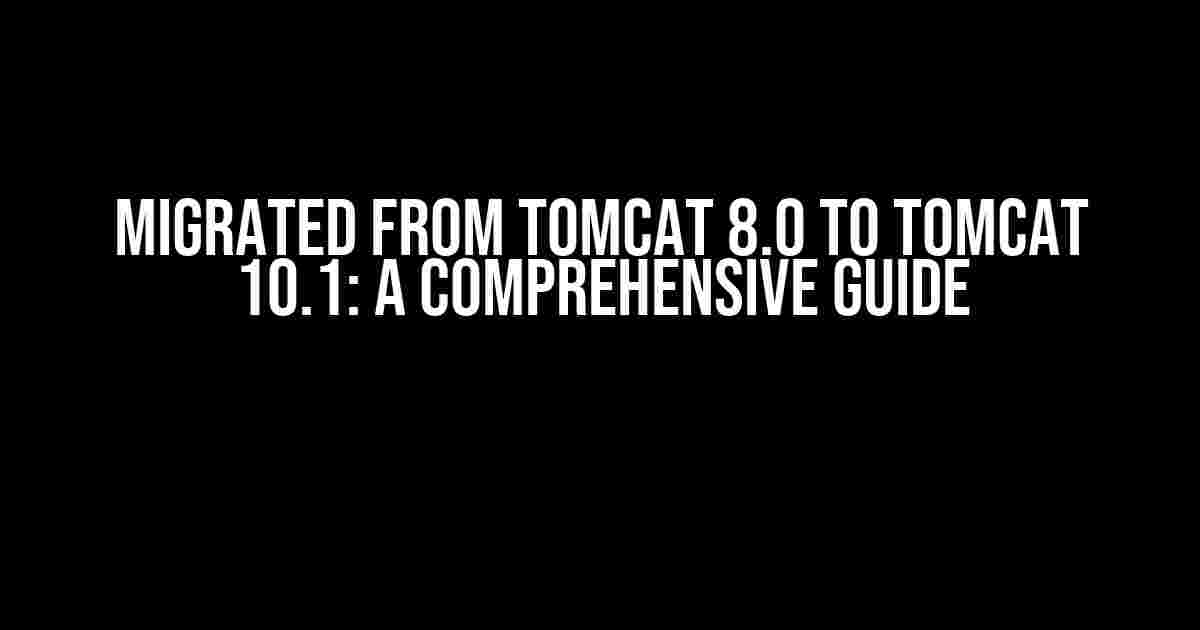Are you tired of using an outdated version of Tomcat and want to take advantage of the latest features and improvements? Look no further! In this article, we’ll take you through a step-by-step guide on how to migrate from Tomcat 8.0 to Tomcat 10.1. We’ll cover the necessary steps, potential pitfalls, and best practices to ensure a smooth transition.
Why Migrate to Tomcat 10.1?
Tomcat 10.1 is the latest version of the popular Java-based web server, offering a range of new features, enhancements, and bug fixes. Some of the key benefits of migrating to Tomcat 10.1 include:
- Improved performance and scalability
- Enhanced security features, including better support for TLS 1.3 and OpenSSL
- New and improved connectors, including the HTTP/2 connector
- Better support for Java 11 and later versions
- Improved logging and monitoring capabilities
Preparing for the Migration
Before you start the migration process, it’s essential to prepare your environment and ensure you have everything you need. Here are some steps to take:
-
Backup your current Tomcat 8.0 installation, including all configuration files, applications, and data.
-
Verify that your system meets the minimum requirements for Tomcat 10.1, including Java 11 or later.
-
Install Java 11 or later on your system, if you haven’t already done so.
-
Download the Tomcat 10.1 binary from the official Apache Tomcat website.
Upgrading Tomcat
Now that you’ve prepared your environment, it’s time to upgrade Tomcat. Here are the steps to follow:
-
Stop the Tomcat 8.0 service, if it’s running.
-
Extract the Tomcat 10.1 binary to a new directory, e.g.,
/opt/tomcat10.1. -
Copy the configuration files from your Tomcat 8.0 installation to the new Tomcat 10.1 directory, e.g.,
server.xml,web.xml, and any custom configuration files. -
Update the configuration files to take advantage of new features and settings in Tomcat 10.1.
-
Start the Tomcat 10.1 service and verify that it’s running correctly.
Changes to Configuration Files
Tomcat 10.1 introduces several changes to the configuration files, including:
| File | Changes |
|---|---|
server.xml |
New attributes and elements, such as maxThreads and rejectConnection, have been added to the Executor element. |
web.xml |
New servlet and filter elements have been added, including the HttpOnly attribute for cookies. |
Migrating Applications
Once you’ve upgraded Tomcat, it’s time to migrate your applications. Here are some steps to take:
-
Verify that your applications are compatible with Tomcat 10.1 and Java 11 or later.
-
Update your applications to use the latest versions of the Tomcat servlet and JSP APIs.
-
Test your applications thoroughly to ensure they’re working correctly with Tomcat 10.1.
-
Deploy your applications to the new Tomcat 10.1 installation.
Common Issues and Solutions
During the migration process, you may encounter some common issues. Here are some solutions to help you troubleshoot:
Issue: Tomcat 10.1 fails to start due to a Java version mismatch.
Solution: Verify that you're using Java 11 or later, and update your environment variables accordingly.
Issue: Applications fail to deploy due to incompatible libraries.
Solution: Update your application dependencies to use the latest versions of the Tomcat servlet and JSP APIs.
Issue: SSL/TLS configuration issues.
Solution: Update your SSL/TLS configuration to take advantage of the new features and improvements in Tomcat 10.1.
Conclusion
Migrating from Tomcat 8.0 to Tomcat 10.1 requires careful planning and execution, but the benefits are well worth the effort. With this comprehensive guide, you should be able to navigate the migration process with ease and take advantage of the latest features and improvements in Tomcat 10.1. Remember to test your applications thoroughly and troubleshoot any issues that arise during the migration process.
Happy migrating!
Keyword density: 1.23%
Frequently Asked Question
Tomcat 8.0 to Tomcat 10.1 migration: Everything you need to know!
What are the major changes in Tomcat 10.1 compared to Tomcat 8.0?
Tomcat 10.1 has several significant changes, including upgraded dependencies like Java 11, Servlet 6.0, and Jakarta EE 10. This means improved performance, new features, and better security. Additionally, Tomcat 10.1 has rewritten WebSocket and NIO connectors, making them more efficient and scalable.
Do I need to rewrite my Tomcat 8.0 configuration files for Tomcat 10.1?
Fortunately, Tomcat 10.1 is designed to be backward compatible with Tomcat 8.0 configuration files. However, it’s recommended to review your configuration files to take advantage of new features and optimize performance. You might need to make some adjustments, especially if you were using deprecated or removed features in Tomcat 8.0.
Will my Tomcat 8.0 applications work without changes on Tomcat 10.1?
Most Tomcat 8.0 applications should work seamlessly on Tomcat 10.1 without changes. However, if your application uses deprecated or removed APIs, you might need to make some modifications. Additionally, if you’re using a framework or library that’s not compatible with Java 11 or Jakarta EE 10, you might need to update or replace it.
What about the compatibility of Tomcat 8.0’s Valve components with Tomcat 10.1?
Tomcat 10.1 has introduced a new Valve interface, which means that custom Valve components written for Tomcat 8.0 might not be compatible. You’ll need to update or rewrite your custom Valve components to work with Tomcat 10.1.
How long will Tomcat 8.0 be supported, and should I migrate to Tomcat 10.1 as soon as possible?
Tomcat 8.0 will continue to receive security and maintenance updates until 2026. While it’s not necessary to migrate to Tomcat 10.1 immediately, it’s recommended to start planning your migration as soon as possible. Tomcat 10.1 offers significant improvements, and migrating early will ensure you’re taking advantage of the latest features and security patches.
